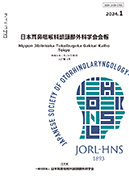Volume 127, Issue 1
Displaying 1-10 of 10 articles from this issue
- |<
- <
- 1
- >
- >|
Review article
-
Article type: review-article
2024 Volume 127 Issue 1 Pages 1-9
Published: January 20, 2024
Released on J-STAGE: February 01, 2024
Download PDF (871K) -
Article type: review-article
2024 Volume 127 Issue 1 Pages 10-15
Published: January 20, 2024
Released on J-STAGE: February 01, 2024
Download PDF (2023K) -
Article type: review-article
2024 Volume 127 Issue 1 Pages 16-23
Published: January 20, 2024
Released on J-STAGE: February 01, 2024
Download PDF (4021K) -
Article type: review-article
2024 Volume 127 Issue 1 Pages 24-26
Published: January 20, 2024
Released on J-STAGE: February 01, 2024
Download PDF (627K)
Original article
-
Article type: Original article
2024 Volume 127 Issue 1 Pages 27-37
Published: January 20, 2024
Released on J-STAGE: February 01, 2024
Download PDF (523K) -
Article type: Original article
2024 Volume 127 Issue 1 Pages 38-44
Published: January 20, 2024
Released on J-STAGE: February 01, 2024
Download PDF (795K)
Training lecture
-
2024 Volume 127 Issue 1 Pages 46-49
Published: January 20, 2024
Released on J-STAGE: February 01, 2024
Download PDF (485K)
Skill up lecture
-
2024 Volume 127 Issue 1 Pages 50-53
Published: January 20, 2024
Released on J-STAGE: February 01, 2024
Download PDF (337K)
ANL Secondary Publication
-
2024 Volume 127 Issue 1 Pages 54-56
Published: January 20, 2024
Released on J-STAGE: February 01, 2024
Download PDF (931K) -
Changes during medical treatments before adenotonsillectomy in children with obstructive sleep apnea2024 Volume 127 Issue 1 Pages 57-58
Published: January 20, 2024
Released on J-STAGE: February 01, 2024
Download PDF (169K)
- |<
- <
- 1
- >
- >|
